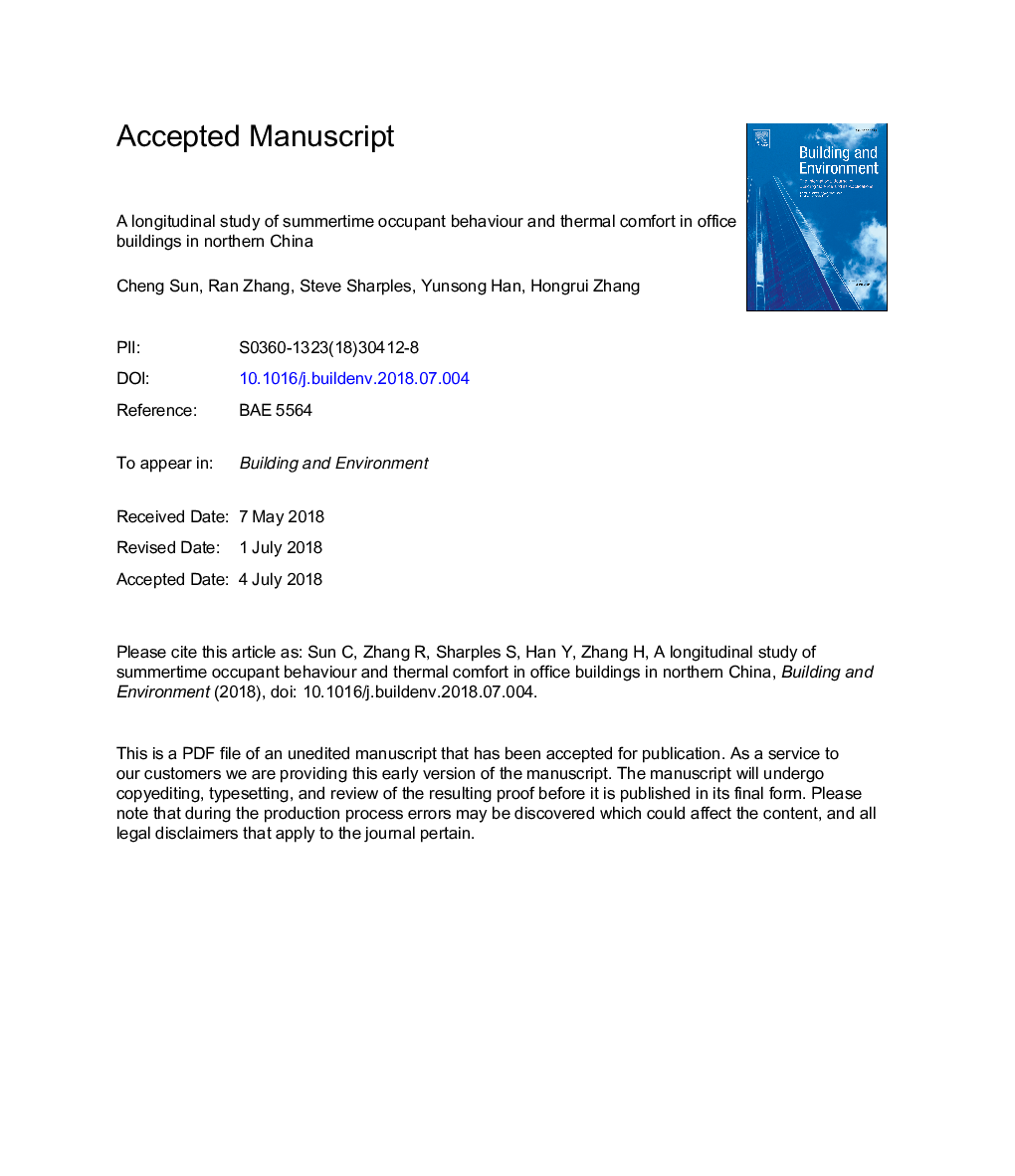| کد مقاله | کد نشریه | سال انتشار | مقاله انگلیسی | نسخه تمام متن |
|---|---|---|---|---|
| 6696608 | 1428349 | 2018 | 37 صفحه PDF | دانلود رایگان |
عنوان انگلیسی مقاله ISI
A longitudinal study of summertime occupant behaviour and thermal comfort in office buildings in northern China
ترجمه فارسی عنوان
یک مطالعه طولی در مورد رفتار ساکنان تابستان و راحتی حرارتی در ساختمان های اداری در شمال چین
دانلود مقاله + سفارش ترجمه
دانلود مقاله ISI انگلیسی
رایگان برای ایرانیان
کلمات کلیدی
رفتار اشخاص، راحتی حرارتی، بررسی طولی، دفتر متفرقه منطقه سرد شدید
ترجمه چکیده
رفتار سازگاری و پاسخهای حرارتی ساختمان سازندگان می توانند در مقایسه با عملکرد ساختمان های نظارت شده و مدل سازی شده، ناشی از عدم اطمینان قابل توجهی باشند. درک درستی از تعامل ساکنان و ساختمان های آنها برای مدیریت این عدم قطعیت و کاهش اختلاف بین مصرف انرژی پیش بینی شده و واقعی (که معمولا به عنوان "شکاف عملکرد" شناخته می شود) ضروری است. این مقاله نتایج حاصل از یک مطالعه طولی در طول فصل تابستان ده اداری مخلوطی که در هاربین، یک شهر در شمال چین واقع شده و زمستان های شدید و تابستان های گرم را تجربه می کند، ارائه می دهد. این مطالعه داده ها را از نظرسنجی روزانه آنلاین، اندازه گیری های محیط محیط محلی، تجربیات ساکنان و رفتارهای کنترل انطباق جمع آوری کرد. تعاملات استخدامی با توجه به رفتار سازگار، حس گرهای درک شده در محیط فیزیکی، متغیرهای هندسی معماری و ویژگی های پرسنلی مورد تجزیه و تحلیل قرار گرفت. مکانیزم های رانندگی برای رفتار و احساس نیز مورد مطالعه قرار گرفتند. نتایج نشان داد که احتمال زیاد باز شدن پنجره برای هر دو روز و شب و فرکانس بالا استفاده از ترکیبی از گزینه های خنک کننده، از جمله طرفداران و تهویه مطبوع، همراه با تهویه طبیعی در فصل تابستان. تعامل فعال محیط داخلی ادارات با محیط بیرون، سبب ارتباط بیشتر احساسات حرارتی اشخاص با متغیرهای فیزیکی در فضای باز شد. سطوح رطوبت نسبی پیش بینی کننده های کلیدی بالقوه برای باز شدن پنجره بود، و پارامترهای هندسی دفاتر، استفاده از فن ساکنان و احساسات حرارتی درک شده نیز سطح توانایی پیش بینی را نشان دادند. ارزیابی ماهیت تعاملات احساسات و رفتارهای ساکنین می تواند نتایج حاصل از طراحی مبتنی بر عملکرد را بهبود بخشد.
موضوعات مرتبط
مهندسی و علوم پایه
مهندسی انرژی
انرژی های تجدید پذیر، توسعه پایدار و محیط زیست
چکیده انگلیسی
The adaptive behaviour and thermal responses of building occupants can be responsible for significant uncertainties when comparing monitored and modelled building energy performance. A better understanding of the interaction of occupants and their buildings is necessary for managing this uncertainty and reducing discrepancies between predicted and actual energy use (commonly known as 'the performance gap'). This paper presents the results from a longitudinal study during a summer season of ten mixed-mode offices located in Harbin, a city in northern China, which experiences severe winters and warm summers. The study collected data from on-line daily surveys, field measurements of the local environment, occupants' experiences and adaptive control behaviours. Occupant-building interactions were analysed through observing adaptive behaviour, perceived thermal sensations in the physical environment, architectural geometric variables and personnel characteristics. The driving mechanisms for behaviours and feelings were also studied. The results showed a high probability of window opening for both day and night, and a high frequency of the use of a mix of cooling options, including fans and air conditioning, accompanied by natural ventilation in the summer season. The active interaction of the offices' internal environments with the outdoor environment motivated more connections of occupant thermal feelings with the outdoor physical variables. Relative humidity levels were potential key predictors for window opening, and the geometric parameters of offices, occupants' fan use and perceived thermal feelings also showed a level of predictive ability. Evaluating the nature of occupant feelings and behaviours interactions may inform and improve results from building performance-based design.
ناشر
Database: Elsevier - ScienceDirect (ساینس دایرکت)
Journal: Building and Environment - Volume 143, 1 October 2018, Pages 404-420
Journal: Building and Environment - Volume 143, 1 October 2018, Pages 404-420
نویسندگان
Cheng Sun, Ran Zhang, Steve Sharples, Yunsong Han, Hongrui Zhang,
